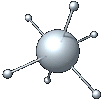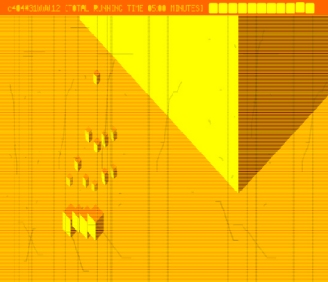
review net art
the interface is the massage - yoshi sodeoka: curt cloninger
download pdf
 |
intelligent
agent vol. 3 no. 1
review net art the interface is the massage - yoshi sodeoka: curt cloninger download pdf |
The Interface is the Massage:
|
net art |
"I get ideas, I get emotion / I want a nice little boat
made out of ocean"
Television
Preparing to write about Yoshi Sodeoka's net art, I select the appropriate soundtrack for the task -- Mum's "Finally We Are No One" and Television's "Marquee Moon." Yoshi himself makes CDs of what's been called "lowercase sound," subtle ambient noises amplified and sequenced to create semi-structure from chaos. Except Sodeoka's own flavor is more like "uppercase sound," punkish, static-laden instrumentals with most of their noise garnished from analog electronic equipment misbehaving as only analog electronic equipment can. The type of sounds Britney Spears pays big studio bucks to filter out of her albums, those are the sounds Sodeoka farms. His visual art is similar to his audio experimentation, glitchy, lo-fi, and analog-derived. Sodeoka even made a 30 minute DVD visually interpreting one of his previously recorded audio tracks. I sent Yoshi the following email telling him what I thought of it:

1. It is beautiful.
2. You turned my tv screen from a
window into a remarkably accurate
synesthetic canvas.
3. Any DVD with a seizure warning
has got to be good.
Foucault would advise, "Never
shoot a pistol that weighs less than
the bullet." (Particularly in a vacuum!)
Fortunately your DVD ignores
such advice. Its soundtrack/bullet is
simply too heavy for the visual pistol
that ostensibly propels it, and the
crack backfiring result is an audio-driven
analog glitchfest of
laughing/intricate spark: rare spy-cam/
dressing-room footage of The
Ghost In The Machine trying on a
rayon Devo tank top, her bare electronic
midriff glittering
forbiddenly in all its (heretofore)
undocumented glory. "And if there's
one thing I can't stand, it's up."
You are truly the spirit of Paul Klee
reembodied in a hand-held Coleco
football game that's just started to malfunction right
before its 9V battery dies -- multiplied by an exponential
equation whose parameters I'm not yet at liberty to
divulge.
Bear down on the splaying profundity, and marvelous
things will happen.
In addition to the abstract DVD and the glitchy analog noise music, Yoshi Sodeoka makes some Internet art. Actually, that's what he's best at. He has the programming chops and the graphic design skills, but rather than pursue the gorgeous shockwave sheen of turux.org or praystation.com, Sodeoka continues to wallow in Blippy Retro Pixel Chunk Land. (It's a good thing.)

His first noteworthy piece, Prototype #19, (featured at Wired's RGB gallery) was a series of 5 pseudo machines, each a bit less likely to crash your browser than the last. As with much of Sodeoka's work, the goal is to map all this abstract retro-electronic funk to some sort of meaningful measure. Although the machines themselves display ridiculous reams of pseudo-data, each machine's interface is a bit simpler than the last, a study in relative abstraction. The interface is the art. The "data/content/information" is just an excuse for the existence of the interface.
Years later, Sodeoka's piece for the Whitney's Artport, Prototype #38, still celebrates the analog, but with a bit more emphasis on the data itself. Yet another machine, this one actually works, parsing and displaying real search terms entered in real time into real search engines by real people. The machine then assigns each term a pseudo-spiritual significance via various unintelligible interface outputs. More concept; less play. Yet despite the "real" data and the attempt to spiritualize it in some meaningful way, the interesting "art" of the piece still lies in its abstract interface.
Fake data or real data, surveillance cameras or internet spy software, in the end, Yoshi Sodeoka is tracking the aesthetic vibe of the interface itself. He's not interested in the slick, digital, Adobe-software-generated interfaces of the commercial web. He's not even interested in the neo-dada, binary-happy ascii interfaces of jodi.org et al. Sodeoka is more interested in the marriage of a late 1950s missile guidance system and a mid-'70s Moog Synthesizer. The heavy, gliding roll of the chrome knobs on an old Marantz amplifier; the feel of that reassuring plastic CLICK as you insert an Asteroids cartridge into an Atari gaming console -- these are Sodeoka's muses.

Is there a concept behind all this interface fetishism? McLuhan said that previous media become the content of current media... which is a nice sound byte, but tangential to Sodeoka's work. Brian Eno hits much closer to the mark:
Although designers continue to dream of 'transparency' - technologies that just do their job without making their presence felt - both creators and audiences actually like technologies with 'personality.' A personality is something with which you can have a relationship. Which is why people return to pencils, violins, and the same three guitar chords.
Alienated by the impersonal churn of self-reflexive, obligatorily conceptual "multimedia art," the mere tangible familiarity of a dial tone can start to seem pretty warm. Is Yoshi Sodeoka's retro-tech fetishism an indictment of the frigidity of contemporary art? I'd love to answer that question, but I've got a date with my stratocaster.
- Curt Cloninger
home: http://www.lab404.com
garden: http://www.playdamage.org